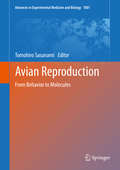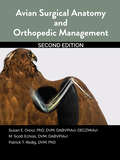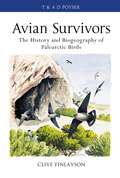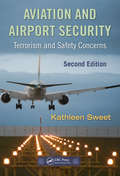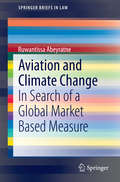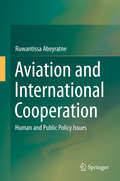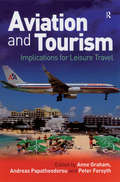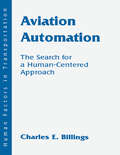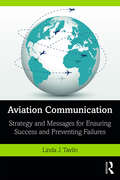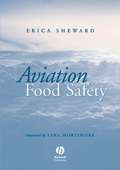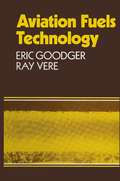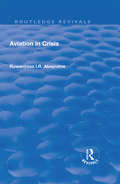- Table View
- List View
Avian Reproduction: From Behavior to Molecules (Advances in Experimental Medicine and Biology #1001)
by Tomohiro SasanamiThis book provides everything from basic knowledge to the recent understandings of avian reproductive physiology, covering many unique aspects. It will inspire avian biologists as well as researchers in varied fields and will offer important steps towards better fertilization success in birds.In spite of the recent remarkable developments in modern technology, a comprehensive understanding of the reproductive mechanisms is still far in the future due to the diverse reproductive tactics in vertebrates. Birds have highly refined reproductive strategies and some of those strategies are unique to birds. However, together with ongoing progress of the genome analysis of birds and the crying need for further increase in meat and egg production, research on avian reproduction is now accelerating and becoming more important.With contributions by leading scientists, the book explains avian primordial germ cells; the sex-determining mechanism; reproductive endocrinology and immunology; sperm, egg, and egg coat; sperm–egg interaction; polyspermic fertilization; seasonal reproduction; social triggers; hormonal and behavioral changes; broodiness; oviductal sperm storage; and biotechnology. This book is recommended for all researchers and students who are interested in birds or reproduction.
Avian Surgical Anatomy And Orthopedic Management, 2nd Edition
by Susan Orosz Scott Echols Patrick RedigAvian Surgical Anatomy: Thoracic and Pelvic Limbs by Orosz, Ensley and Haynes, was published in 1992 and has served as a standard guide for those performing orthopedic surgery on birds. That foundational work is out of print but the need for a concise source of avian surgical anatomy has not changed. Our objective in this edition has been to recapture the musculoskeletal anatomy of the original work and to expand the scope to include comprehensive coverage for the clinical management of common fractures of the long bones of birds, primarily raptors. The procedures described have been honed over two decades of development and refinement by clinicians at the Raptor Center at the University of Minnesota. In addition, we have included details of the vascular anatomy of the limbs, further informing the surgeon and clinician. The class Aves includes thousands of species with countless anatomic variations. Although it is impractical to represent every species, birds commonly encountered in private practice and rehabilitation medicine including poultry, pigeons, parrots and birds of prey were chosen for this book. Details of the vascular anatomy of the limbs were obtained by high resolution digital computed tomography imaging of the appendicular skeleton of several diverse bird species. These images provide a unique comparative aspect that clinicians will find useful in conducting surgical procedures. This new information is intended to help the reader better understand skeletal and vascular anatomy, and thus improve interpretation, reporting of findings, treatment and teaching. This new information is intended to help the reader better understand relationships between musculoskeletal and vascular anatomy, helping the surgeon preserve vasculature during complex orthopedic procedures. It is our hope that it will enrich the interpretation, reporting of findings, development of treatment methods and the teaching of management procedures for orthopedic issues in birds. Since publication of the first edition, numerous advances have been made and published relative to avian orthopedics. In this edition, you will find comprehensive discussion of orthopedic conditions, and clinical management that represents best treatment options and current practices. The title of the book has been changed to reflect inclusion of that information. As our knowledge of avian anatomy, health and disease progresses, so does the need for improved resources that convey this valuable information. Over time the information contained herein will also need to be expanded and updated. The authors humbly submit this work to the veterinary and scientific community for review and scrutiny. We hope that it will contribute to the betterment of avian care.
Avian Surgical Anatomy And Orthopedic Management, 2nd Edition
by Susan Orosz Scott Echols Patrick RedigAvian Surgical Anatomy: Thoracic and Pelvic Limbs by Orosz, Ensley and Haynes, was published in 1992 and has served as a standard guide for those performing orthopedic surgery on birds. That foundational work is out of print but the need for a concise source of avian surgical anatomy has not changed. Our objective in this edition has been to recapture the musculoskeletal anatomy of the original work and to expand the scope to include comprehensive coverage for the clinical management of common fractures of the long bones of birds, primarily raptors. The procedures described have been honed over two decades of development and refinement by clinicians at the Raptor Center at the University of Minnesota. In addition, we have included details of the vascular anatomy of the limbs, further informing the surgeon and clinician. The class Aves includes thousands of species with countless anatomic variations. Although it is impractical to represent every species, birds commonly encountered in private practice and rehabilitation medicine including poultry, pigeons, parrots and birds of prey were chosen for this book. Details of the vascular anatomy of the limbs were obtained by high resolution digital computed tomography imaging of the appendicular skeleton of several diverse bird species. These images provide a unique comparative aspect that clinicians will find useful in conducting surgical procedures. This new information is intended to help the reader better understand skeletal and vascular anatomy, and thus improve interpretation, reporting of findings, treatment and teaching. This new information is intended to help the reader better understand relationships between musculoskeletal and vascular anatomy, helping the surgeon preserve vasculature during complex orthopedic procedures. It is our hope that it will enrich the interpretation, reporting of findings, development of treatment methods and the teaching of management procedures for orthopedic issues in birds. Since publication of the first edition, numerous advances have been made and published relative to avian orthopedics. In this edition, you will find comprehensive discussion of orthopedic conditions, and clinical management that represents best treatment options and current practices. The title of the book has been changed to reflect inclusion of that information. As our knowledge of avian anatomy, health and disease progresses, so does the need for improved resources that convey this valuable information. Over time the information contained herein will also need to be expanded and updated. The authors humbly submit this work to the veterinary and scientific community for review and scrutiny. We hope that it will contribute to the betterment of avian care.
Avian survivors: The History and Biogeography of Palearctic Birds
by Clive FinlaysonThe impacts of global warming are of concern to all of us. Thepotential responses of birds to climate change have come increasinglyto the fore, and are of particular interest to the ornithologicalcommunity. Are birds sensitive to climate change and how will theyreact to a world of global warming? These are the key issues to beexplored in this book, with particular reference to Western Palearcticbirds. Climate changes that have affected the region in the last two millionyears will be explored, drawing on published data on fossil birds. Amajor part of the book will be devoted to the distribution of WesternPalearctic birds in relation to bioclimate. The final section of thebook looks at migration and the relationship of the Western Palearcticto Africa.
Avian survivors: The History and Biogeography of Palearctic Birds (Poyser Monographs)
by Clive FinlaysonThe impacts of global warming are of concern to all of us. Thepotential responses of birds to climate change have come increasinglyto the fore, and are of particular interest to the ornithologicalcommunity. Are birds sensitive to climate change and how will theyreact to a world of global warming? These are the key issues to beexplored in this book, with particular reference to Western Palearcticbirds. Climate changes that have affected the region in the last two millionyears will be explored, drawing on published data on fossil birds. Amajor part of the book will be devoted to the distribution of WesternPalearctic birds in relation to bioclimate. The final section of thebook looks at migration and the relationship of the Western Palearcticto Africa.
Aviation and Airport Security: Terrorism and Safety Concerns, Second Edition
by Kathleen SweetThe Definitive Handbook on Terrorist Threats to Commercial Airline and Airport SecurityConsidered the definitive handbook on the terrorist threat to commercial airline and airport security, USAF Lieutenant Colonel Kathleen Sweet‘s seminal resource is now updated to include an analysis of modern day risks. She covers the history of aviation security
Aviation and Climate Change: In Search of a Global Market Based Measure (SpringerBriefs in Law)
by Ruwantissa AbeyratneThe book addresses the most critical issue faced by aviation and climate change: namely the development of a market based measure to control aircraft engine emissions. It discusses the current market economic trends as they impact to aviation and suggests steps and measures to be taken in the development of a workable MBM. ICAO has three years to come up with such an MBM on a global scale and this book will spur discussions on how to achieve this objective.
Aviation and Human Factors: How to Incorporate Human Factors into the Field
by Jose Sanchez-AlarcosAir safety is right now at a point where the chances of being killed in an aviation accident are far lower than the chances to winning a jackpot in any of the major lotteries. However, keeping or improving that performance level requires a critical analysis of some events that, despite scarce, point to structural failures in the learning process. The effect of these failures could increase soon if there is not a clear and right development path. This book tries to identify what is wrong, why there are things to fix, and some human factors principles to keep in aircraft design and operations. Features Shows, through different events, how the system learns through technology, practices, and regulations and the pitfalls of that learning process Discusses the use of information technology in safety-critical environments and why procedural knowledge is not enough Presents air safety management as a successful process, but at the same time, failures coming from technological and organizational features are shown Offers ways to improve from the human factors side by getting the right lessons from recent events
Aviation and Human Factors: How to Incorporate Human Factors into the Field
by Jose Sanchez-AlarcosAir safety is right now at a point where the chances of being killed in an aviation accident are far lower than the chances to winning a jackpot in any of the major lotteries. However, keeping or improving that performance level requires a critical analysis of some events that, despite scarce, point to structural failures in the learning process. The effect of these failures could increase soon if there is not a clear and right development path. This book tries to identify what is wrong, why there are things to fix, and some human factors principles to keep in aircraft design and operations. Features Shows, through different events, how the system learns through technology, practices, and regulations and the pitfalls of that learning process Discusses the use of information technology in safety-critical environments and why procedural knowledge is not enough Presents air safety management as a successful process, but at the same time, failures coming from technological and organizational features are shown Offers ways to improve from the human factors side by getting the right lessons from recent events
Aviation and International Cooperation: Human and Public Policy Issues
by Ruwantissa AbeyratneThis book addresses an essential gap in the regulatory regime, which provides legislation, statements and guidelines on airlines, airports, air navigation services providers and States in the field of aviation, but is notably lacking when it comes to the rights of the airline passenger, and the average citizen who is threatened by military air strikes. It addresses subjects such as international resolutions on human rights and other human rights conventions related to aviation that impact both air transport consumers and people on the ground who are threatened by air strikes through drone attacks; disabled and obese airline passengers; compensation for delayed carriage and the denial of carriage; noise and air pollution caused by aviation and their effects on human health and wellbeing; prevention of death or injury to passengers and attendant compensatory rights; risk management; relief flights; and racial profiling. These subjects are addressed against the backdrop of real case studies that include but are not limited to instances of drone attacks, and contentious flights in the year 2014 such as MH 370, MH 17 and QZ 8501.
Aviation and Tourism: Implications for Leisure Travel
by Anne Graham Andreas Papatheodorou Peter ForsythTransport is an essential element of tourism, providing the vital link between the tourist generating areas and destinations. Good accessibility, which is determined by the transport services provided, is a fundamental condition for the development of any tourist destination. Moreover the transport industry can be a major beneficiary of tourism because of the additional passenger demand that may be generated. Aviation is an increasingly important mode of transport for tourism markets. Whilst geography has meant that, in modern times, air travel has always been the dominant mode for long distance travel and much international tourism, moves towards deregulation, and in particular the emergence of the low cost carrier sector, have also increased aviation's significance for short and medium haul tourism trips. Thus developments in aviation can have very major implications for many leisure and business tourism markets. However the characteristics and needs of leisure travellers are generally so very different from business travellers that this necessitates a separate consideration of these markets if a detailed understanding of the relationship with aviation is to be gained. In spite of the obvious closeness between the aviation and tourism industries, there are very few specialist texts on this subject. Most tourism focused books consider aviation as just one component of the tourism industry which needs to be discussed, whereas aviation specialist texts rarely concentrate on just leisure travel. In addition there is very little literature that gives a detailed appreciation of the complexities and potential conflicts associated with the development of coherent and effective aviation and tourism policies. Therefore it is the aim of this book to fill this important gap which exists with a comprehensive, in-depth study of the relationship between aviation and leisure travel. The book deals exclusively with issues related to the relationship between aviation and leisure travel. It does this with an analysis of the theoretical concepts relevant to the subject area combined with a detailed investigation of current practice within the aviation and tourism industries. Each chapter is illustrated with case study material that will reinforce the understanding of the issues that are being examined.
Aviation and Tourism: Implications for Leisure Travel
by Anne Graham Andreas Papatheodorou Peter ForsythTransport is an essential element of tourism, providing the vital link between the tourist generating areas and destinations. Good accessibility, which is determined by the transport services provided, is a fundamental condition for the development of any tourist destination. Moreover the transport industry can be a major beneficiary of tourism because of the additional passenger demand that may be generated. Aviation is an increasingly important mode of transport for tourism markets. Whilst geography has meant that, in modern times, air travel has always been the dominant mode for long distance travel and much international tourism, moves towards deregulation, and in particular the emergence of the low cost carrier sector, have also increased aviation's significance for short and medium haul tourism trips. Thus developments in aviation can have very major implications for many leisure and business tourism markets. However the characteristics and needs of leisure travellers are generally so very different from business travellers that this necessitates a separate consideration of these markets if a detailed understanding of the relationship with aviation is to be gained. In spite of the obvious closeness between the aviation and tourism industries, there are very few specialist texts on this subject. Most tourism focused books consider aviation as just one component of the tourism industry which needs to be discussed, whereas aviation specialist texts rarely concentrate on just leisure travel. In addition there is very little literature that gives a detailed appreciation of the complexities and potential conflicts associated with the development of coherent and effective aviation and tourism policies. Therefore it is the aim of this book to fill this important gap which exists with a comprehensive, in-depth study of the relationship between aviation and leisure travel. The book deals exclusively with issues related to the relationship between aviation and leisure travel. It does this with an analysis of the theoretical concepts relevant to the subject area combined with a detailed investigation of current practice within the aviation and tourism industries. Each chapter is illustrated with case study material that will reinforce the understanding of the issues that are being examined.
Aviation Automation: The Search for A Human-centered Approach (Human Factors in Transportation)
by Charles E. BillingsThe advent of very compact, very powerful digital computers has made it possible to automate a great many processes that formerly required large, complex machinery. Digital computers have made possible revolutionary changes in industry, commerce, and transportation. This book, an expansion and revision of the author's earlier technical papers on this subject, describes the development of automation in aircraft and in the aviation system, its likely evolution in the future, and the effects that these technologies have had -- and will have -- on the human operators and managers of the system. It suggests concepts that may be able to enhance human-machine relationships in future systems. The author focuses on the ability of human operators to work cooperatively with the constellation of machines they command and control, because it is the interactions among these system elements that result in the system's success or failure, whether in aviation or elsewhere. Aviation automation has provided great social and technological benefits, but these benefits have not come without cost. In recent years, new problems in aircraft have emerged due to failures in the human-machine relationship. These incidents and accidents have motivated this inquiry into aviation automation. Similar problems in the air traffic management system are predicted as it becomes more fully automated. In particular, incidents and accidents have occurred which suggest that the principle problems with today's aviation automation are associated with its complexity, coupling, autonomy, and opacity. These problems are not unique to aviation; they exist in other highly dynamic domains as well. The author suggests that a different approach to automation -- called "human-centered automation" -- offers potential benefits for system performance by enabling a more cooperative human-machine relationship in the control and management of aircraft and air traffic.
Aviation Automation: The Search for A Human-centered Approach (Human Factors in Transportation)
by Charles E. BillingsThe advent of very compact, very powerful digital computers has made it possible to automate a great many processes that formerly required large, complex machinery. Digital computers have made possible revolutionary changes in industry, commerce, and transportation. This book, an expansion and revision of the author's earlier technical papers on this subject, describes the development of automation in aircraft and in the aviation system, its likely evolution in the future, and the effects that these technologies have had -- and will have -- on the human operators and managers of the system. It suggests concepts that may be able to enhance human-machine relationships in future systems. The author focuses on the ability of human operators to work cooperatively with the constellation of machines they command and control, because it is the interactions among these system elements that result in the system's success or failure, whether in aviation or elsewhere. Aviation automation has provided great social and technological benefits, but these benefits have not come without cost. In recent years, new problems in aircraft have emerged due to failures in the human-machine relationship. These incidents and accidents have motivated this inquiry into aviation automation. Similar problems in the air traffic management system are predicted as it becomes more fully automated. In particular, incidents and accidents have occurred which suggest that the principle problems with today's aviation automation are associated with its complexity, coupling, autonomy, and opacity. These problems are not unique to aviation; they exist in other highly dynamic domains as well. The author suggests that a different approach to automation -- called "human-centered automation" -- offers potential benefits for system performance by enabling a more cooperative human-machine relationship in the control and management of aircraft and air traffic.
Aviation Communication: Strategy and Messages for Ensuring Success and Preventing Failures
by Linda J. TavlinDo you ever wonder why an airline’s communication strategy can crash and burn in a crisis? A lack of understanding an acceptable aviation communication strategy can, in this fast world of social media, ruin a company’s credibility in the aviation industry. Aviation Communication: Strategy and Messages for Ensuring Success and Preventing Failures is the first go-to book to reveal to everyone in the aviation industry how to stop an organization’s communication strategy from becoming the tragedy-after-the-tragedy that we’ve seen so often. In such instances, after the media go home, the economic, political, regulatory, and legal effects can linger for years. The strategies and messages in this book show how to prevent this along with the ultimate safety net used by those who have been successful. Readers will learn to prevent catastrophic communication mistakes with strategic templates for a wide array of scenarios, as well as 25 specific techniques that give the actual words to use to deliver the book’s messages. This book is a must-have for the international aviation business community as a tri-functional induction, training, and reference tool.
Aviation Communication: Strategy and Messages for Ensuring Success and Preventing Failures
by Linda J. TavlinDo you ever wonder why an airline’s communication strategy can crash and burn in a crisis? A lack of understanding an acceptable aviation communication strategy can, in this fast world of social media, ruin a company’s credibility in the aviation industry. Aviation Communication: Strategy and Messages for Ensuring Success and Preventing Failures is the first go-to book to reveal to everyone in the aviation industry how to stop an organization’s communication strategy from becoming the tragedy-after-the-tragedy that we’ve seen so often. In such instances, after the media go home, the economic, political, regulatory, and legal effects can linger for years. The strategies and messages in this book show how to prevent this along with the ultimate safety net used by those who have been successful. Readers will learn to prevent catastrophic communication mistakes with strategic templates for a wide array of scenarios, as well as 25 specific techniques that give the actual words to use to deliver the book’s messages. This book is a must-have for the international aviation business community as a tri-functional induction, training, and reference tool.
Aviation Disasters: The World’s Major Civil Airliner Crashes Since 1950
by David GeroFlying as an airline passenger is, statistically, one of the safest forms of travel. Even so, the history of civil aviation is littered with high-profile disasters involving major loss of life. This new edition of the authoritative work on the subject brings the grim but important story of air disasters right up to date. David Gero assembles a list of major air disasters since the 1950s across continents. He investigates every type of calamity, including those caused by appalling weather, mechanical failure, pilot error, inhospitable terrain and hostile action. The first incident of sabotage involving a commercial jetliner is covered, as is the first, much-feared crash of the jumbo jet era. Examined alongside less well-known disasters are high-profile episodes such as that of Pan American Flight 103 at Lockerbie in 1988, the Twin Towers tragedy of 11 September 2001 and, more recently, the disappearance of Malaysia Airlines Flight 370 in 2014 – the greatest mystery of the commercial jet age. Aviation Disasters is the authoritative record of air disasters worldwide, fully illustrated with a fascinating selection of photographs.
Aviation Education and Training: Adult Learning Principles and Teaching Strategies (Studies in Aviation Psychology and Human Factors)
by Irene M. A. HenleyThe aviation teaching environment is fairly unique and combines both traditional and non-traditional teaching environments. There are presently few books that address adult learning principles and teaching strategies relevant to the aviation context. Furthermore, aviation education has not generally benefited from many of the developments made in the field of education. This timely book: - facilitates the development of knowledge and skills necessary to conduct effective instruction and training within the aviation context; - develops an awareness of critical issues that should be of concern to aviation educators and trainers; - provides aviation education and trainers with a variety of teaching strategies that can be effective in the development of essential skills in aviation professionals. The readership for this book includes university students who want to become instructors, as well as industry personnel who are involved in any of the various domains of aviation education, from junior flight instructors to the trainer of instructors, or from training captains, or traffic controllers to crew resource management and human factors facilitators.
Aviation Education and Training: Adult Learning Principles and Teaching Strategies (Studies in Aviation Psychology and Human Factors)
by Irene M.A. HenleyThe aviation teaching environment is fairly unique and combines both traditional and non-traditional teaching environments. There are presently few books that address adult learning principles and teaching strategies relevant to the aviation context. Furthermore, aviation education has not generally benefited from many of the developments made in the field of education. This timely book: - facilitates the development of knowledge and skills necessary to conduct effective instruction and training within the aviation context; - develops an awareness of critical issues that should be of concern to aviation educators and trainers; - provides aviation education and trainers with a variety of teaching strategies that can be effective in the development of essential skills in aviation professionals. The readership for this book includes university students who want to become instructors, as well as industry personnel who are involved in any of the various domains of aviation education, from junior flight instructors to the trainer of instructors, or from training captains, or traffic controllers to crew resource management and human factors facilitators.
Aviation English: A lingua franca for pilots and air traffic controllers (Routledge Research in English for Specific Purposes)
by Dominique Estival Candace Farris Brett MolesworthAviation English investigates the key issues related to the use of English for the purpose of communication in aviation and analyses the current research on language training, testing and assessment in the area of Aviation English. Based on a series of recent empirical studies in aviation communication and taking an interdisciplinary approach, this book: provides a description of Aviation English from a linguistic perspective lays the foundation for increased focus in the area of Aviation English and its assessment in the form of English Language Proficiency (ELP) tests critically assesses recent empirical research in the domain. This book makes an important contribution to the development of the field of Aviation English and will be of interest to researchers in the areas of applied linguistics, TESOL and English for Specific Purposes.
Aviation English: A lingua franca for pilots and air traffic controllers (Routledge Research in English for Specific Purposes)
by Dominique Estival Candace Farris Brett MolesworthAviation English investigates the key issues related to the use of English for the purpose of communication in aviation and analyses the current research on language training, testing and assessment in the area of Aviation English. Based on a series of recent empirical studies in aviation communication and taking an interdisciplinary approach, this book: provides a description of Aviation English from a linguistic perspective lays the foundation for increased focus in the area of Aviation English and its assessment in the form of English Language Proficiency (ELP) tests critically assesses recent empirical research in the domain. This book makes an important contribution to the development of the field of Aviation English and will be of interest to researchers in the areas of applied linguistics, TESOL and English for Specific Purposes.
Aviation Food Safety
by Erica ShewardThe provision of safe food to airline passengers is now a multi-billion dollar industry worldwide. As the aviation industry continues to grow year on year, so do passenger food service expectations, with increasing demand for wider choice and greater quality. Often neglected and under-regulated, food safety should be of paramount importance amid this growth. The consequences of in-flight food poisoning are extremely serious not only for the passengers involved, but also for the crew associated safety of the aircraft, and ultimately the airline’s reputation. In this much needed book Erica Sheward makes a compelling case for better management of food safety for all aspects of the aircraft food supply chain with comprehensive coverage of: HACCP Codes of practice Supply chain logistics Fitness to fly Managing aircraft water safety Liability issues Food Security Manufacturers and suppliers of products to the airline catering industry, business aviation caterers, airline Quality Assurance and hygiene personnel, product development managers, food safety regulators, aviation safety and security regulators, decision makers and company executives in any area of aviation as well as lecturers and students in all areas of the hospitality and travel sectors will find this book a vital tool.
Aviation in Crisis
by Ruwantissa AbeyratneThis title was first published in 2003. The events of 11 September 2001 defy modern economic theory when addressed in aviation terms. Economic theory would suggest that, once the impact of such events are a thing of the past, and economies are restored to their status quo ante, a rise in the gross domestic product of States to earlier levels would almost inevitably result in increased consumption. This in turn would mean that the demand for air travel would rise to earlier proportions and consumption in terms of air transport services would be restored to normalcy. However, the September attacks on United States' property introduced a unique characteristic through the fear factor that directly impacts the future development of air transport. As a result, the grim task of restoration of passenger confidence stands in the way of economic revival of the air transport industry. Aviation was always in crisis. The air transport industry, even prior to 11 September 2001, although seemingly a glamorous, exciting and prosperous business, never enjoyed sustained periods of profitability. Even among the large carriers, a short bout of profitability would inevitably be followed by a period of downturn in real income. It is simply that this fluctuation in fortune is an ineluctable characteristic of air transport, whose fortunes are dictated by rigid regulation, competition and technological change. If a sustained analysis were to be made of air transport, plain economic theory would no longer be the exclusive discipline for consideration. Rather, all relevant factors have to be taken in context and emerging issues should be analyzed as possible threats to the economic well being of the air transport industry. This book addresses issues in a post-September 2001 context but also analyses issues past and present, with the intent of looking at the future. Four major areas are taken into consideration which were in crisis but are truly impacted by the events of September 2001. These areas relate to crises in the commercial, security, insurance and environmental protection fields. Of these the first and fourth areas are inextricably intertwined, as aircraft noise regulations in various States have a direct impact on aircraft financing, which in turn is linked to demand for air services. A drop in demand for air services would essentially mean that the demand for lease or purchase of new aircraft would drop. When this occurs, air transport enterprises would be more inclined to cut costs and therefore concentrate on using the aircraft already at hand, upgrading them to conform to the The purpose of this book is to view the overall picture of an aviation industry - comprising air transport and other aviation related industries - in crisis, through issues that continue to impact the economic viability of air transport, particularly as a result of the events of 11 September 2001.
Aviation in Crisis
by Ruwantissa AbeyratneThis title was first published in 2003. The events of 11 September 2001 defy modern economic theory when addressed in aviation terms. Economic theory would suggest that, once the impact of such events are a thing of the past, and economies are restored to their status quo ante, a rise in the gross domestic product of States to earlier levels would almost inevitably result in increased consumption. This in turn would mean that the demand for air travel would rise to earlier proportions and consumption in terms of air transport services would be restored to normalcy. However, the September attacks on United States' property introduced a unique characteristic through the fear factor that directly impacts the future development of air transport. As a result, the grim task of restoration of passenger confidence stands in the way of economic revival of the air transport industry. Aviation was always in crisis. The air transport industry, even prior to 11 September 2001, although seemingly a glamorous, exciting and prosperous business, never enjoyed sustained periods of profitability. Even among the large carriers, a short bout of profitability would inevitably be followed by a period of downturn in real income. It is simply that this fluctuation in fortune is an ineluctable characteristic of air transport, whose fortunes are dictated by rigid regulation, competition and technological change. If a sustained analysis were to be made of air transport, plain economic theory would no longer be the exclusive discipline for consideration. Rather, all relevant factors have to be taken in context and emerging issues should be analyzed as possible threats to the economic well being of the air transport industry. This book addresses issues in a post-September 2001 context but also analyses issues past and present, with the intent of looking at the future. Four major areas are taken into consideration which were in crisis but are truly impacted by the events of September 2001. These areas relate to crises in the commercial, security, insurance and environmental protection fields. Of these the first and fourth areas are inextricably intertwined, as aircraft noise regulations in various States have a direct impact on aircraft financing, which in turn is linked to demand for air services. A drop in demand for air services would essentially mean that the demand for lease or purchase of new aircraft would drop. When this occurs, air transport enterprises would be more inclined to cut costs and therefore concentrate on using the aircraft already at hand, upgrading them to conform to the The purpose of this book is to view the overall picture of an aviation industry - comprising air transport and other aviation related industries - in crisis, through issues that continue to impact the economic viability of air transport, particularly as a result of the events of 11 September 2001.
